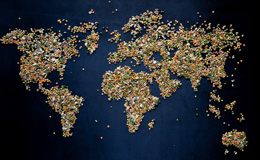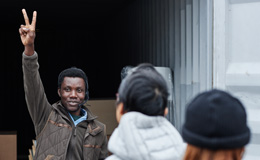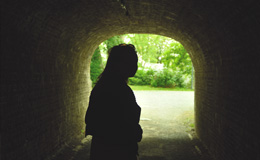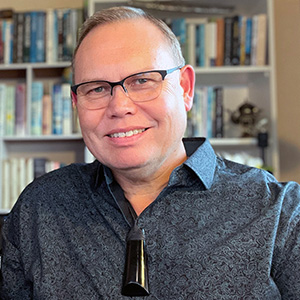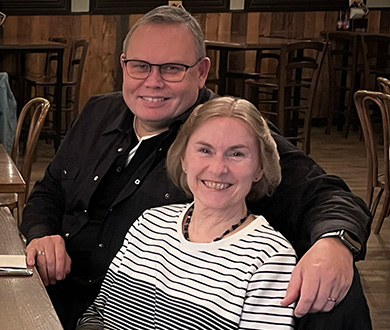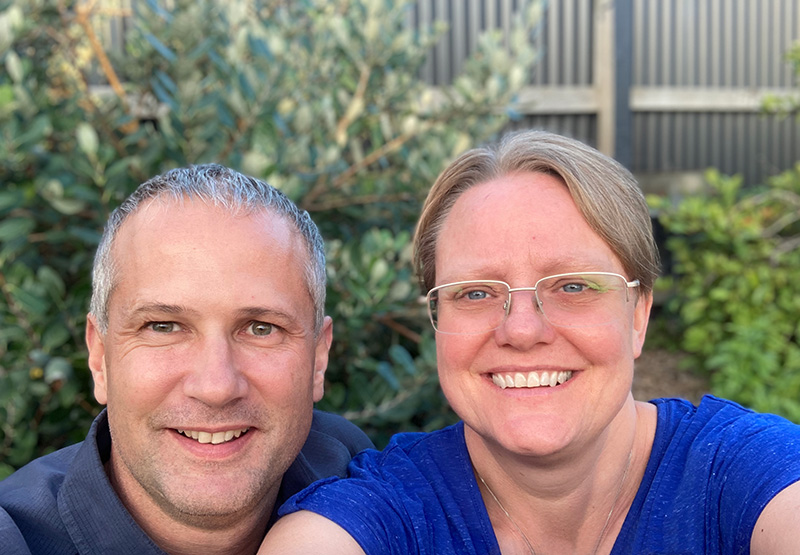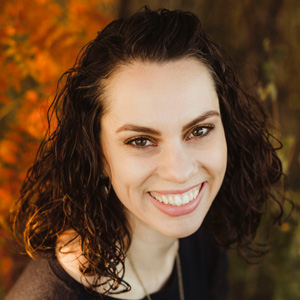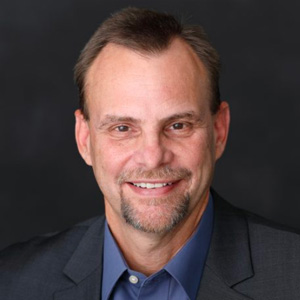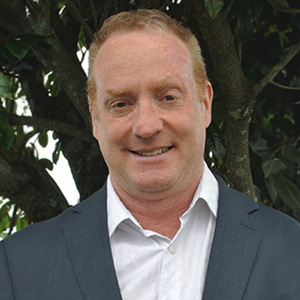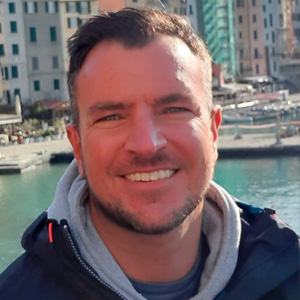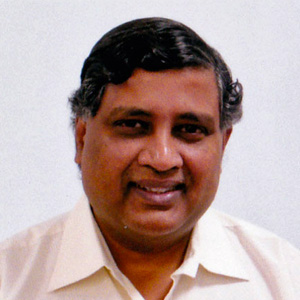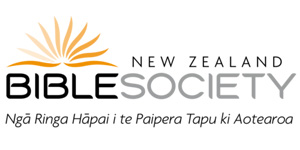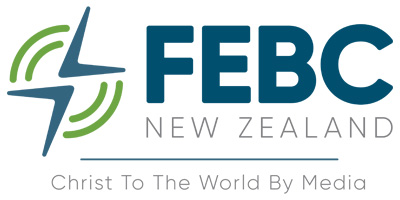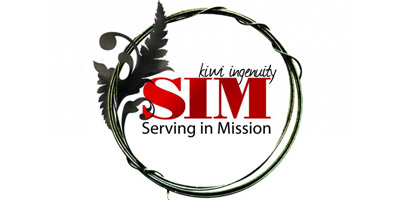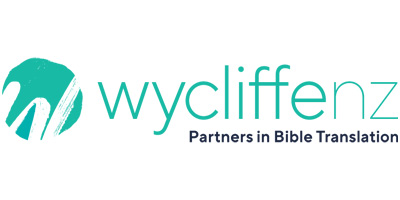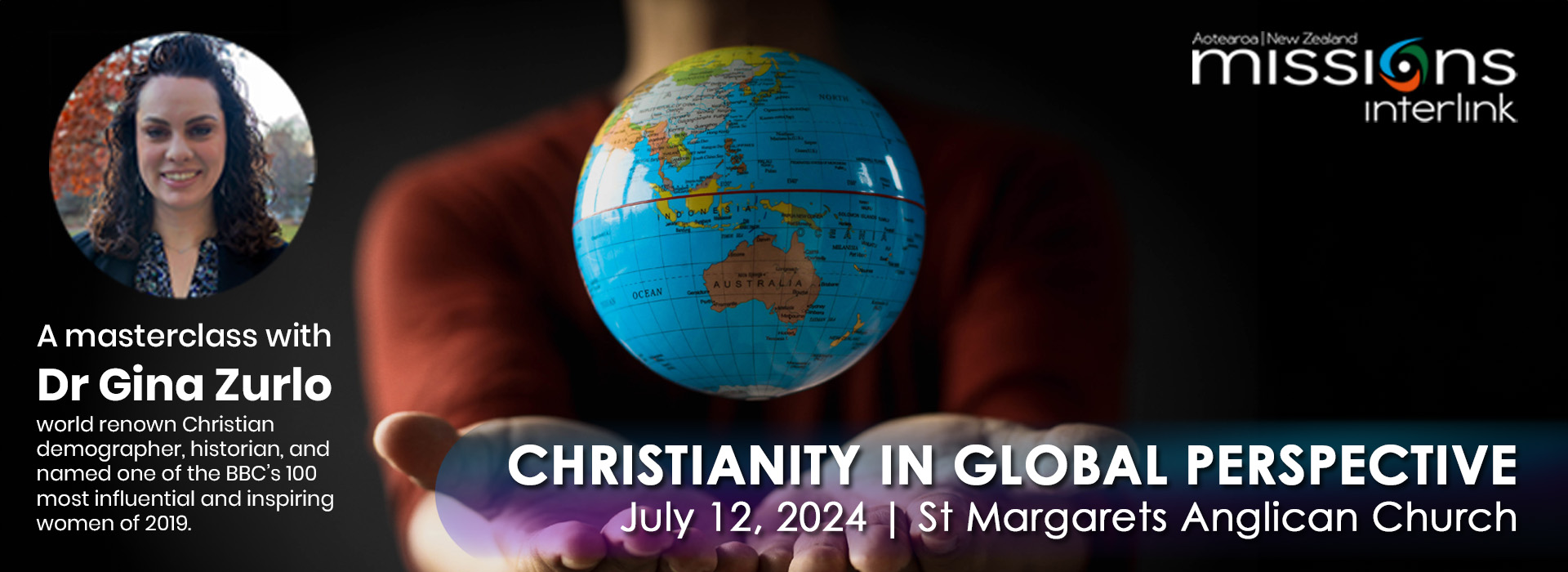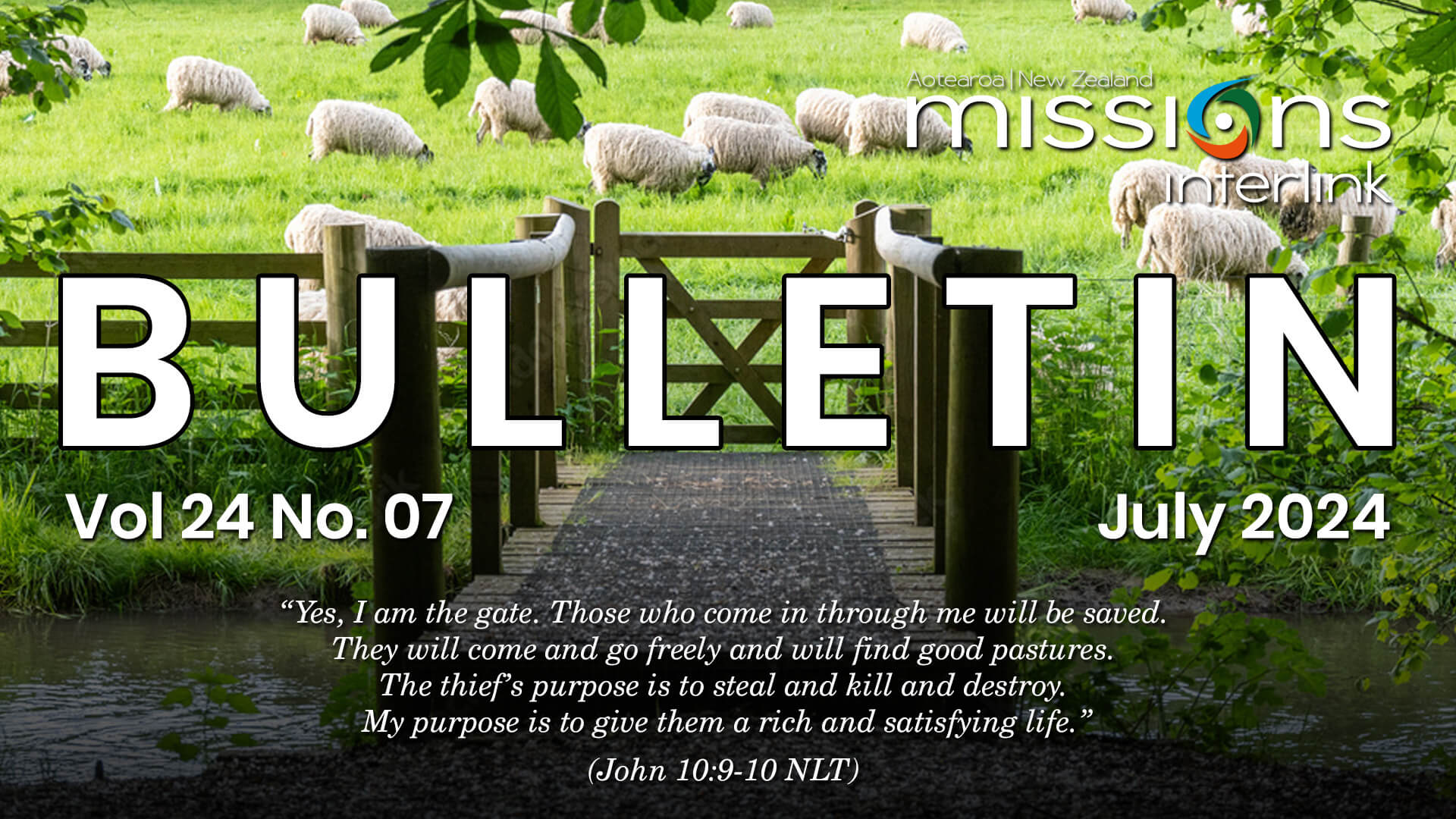
QUICK MENU
EDITORIAL
- Emissaries of the Way
- Administrative Update
EQUIP
- The Genesis 2 Mandate
- Counting Missionaries
GO
- Diaspora Ministry Dilemma
- Major Missions Shift
- Transforming Wash
- The God Who Sees
CARE
- Navigating the Dark Valley
PRAY
- NZBS, FEBC, MINZ, OMF, SIM, WYCLIFFE.
SPOTS
- Christianity in Global Perspective (with Gina Zurlo).
- Latest News. Events & Opportunities

EDITORIAL
EMISSARIES OF THE WAY
By Dr Jay Matenga
Jay is the Executive Officer of Missions Interlink and Executive Director of the World Evangelical Alliance’s Mission Commission. Jay writes and speaks on missions related subjects globally. His blogs, articles, and other public contributions are made available for free on jaymatenga.com
The text for this month is Isaiah 62:10-11 (NLT), “Go out through the gates! Prepare the highway for my people to return! Smooth out the road; pull out the boulders; raise a flag for all the nations to see. The LORD has sent this message to every land: ‘Tell the people of Israel, ‘Look, your Saviour is coming. See, he brings his reward with him as he comes.’’ They will be called ‘The Holy People’ and ‘The People Redeemed by the LORD.’ And Jerusalem will be known as ‘The Desirable Place’ and ‘The City No Longer Forsaken’.”
I am no supersessionist. I don’t believe that Gentile followers of Jesus the Messiah have superseded Israel or the covenant that God established through Abraham and directed through the Mosaic law. The people for whom Abraham, Isaac, and Jacob are their ancestors have their own responsibilities and privileges. All of which are fulfilled in Jesus, whom they must recognise as their Messiah in order to find satisfaction for their millennia of yearning. As I noted in my recent blog post, we Gentiles are settlers to a well-established faith, the Jews (the blood line of Israel) are indigenous. We are grafted into their story. By Jesus’ blood, which has become our blood by faith, securing our inheritance. We are grafted, whangai, adopted, into that story. And the story of every ethnicity in Christ now interweaves with the biblical narrative, past, present, and future. It is the massive tree containing birds of every kind that began as a small seed. It is the increasingly large river that holds fish of every kind. It is the city of New Jerusalem that attracts and welcomes the nations. It is the New Creation.
Each and all of the metaphors used in Scripture to describe New Creation are bounded. There is a border between what it is and what it is not. There is no escaping this. We cannot theologically or conceptually wish it away. Entrance to New Creation requires a valid visa in one’s passport of life to allow entry. Western liberal Christians who argue for open inclusivism would prefer this not be the case. For it not to be necessary, they need to disassociate themselves from the authority of Scripture. They make compelling arguments that seek to relegate the Judeo-Christian texts to a level of helpful historic anecdote that one can take or leave. But without the canon that has been collected by wise teachers of earliest Christianity and passed down to us by wise translators today, our faith is unmoored. We remain “immature like children… tossed and blown about by every wind of new teaching… influenced when people try to trick us with lies so clever they sound like the truth” (Ephesians 4:14). Jesus becomes whoever we want Him to be. We might suppose we can create a Jesus from cherry-picked verses, but the result is about as substantial as cotton wool—it feels wonderful but doesn’t protect us from reality.
On the contrary, Jesus established Himself in Scripture as the monarch of an alternate reality—a Kingdom. He is the anointed ruler long prophesied by the seers and soothsayers of Israel. His first coming challenged (and successfully undermined) one of the greatest empires in history and continues to undermine every empire since—even those who would attempt to co-opt and exploit His name. In the text above, one of those prophets imagined the coming reign as a revitalised Jerusalem, a city bounded by a broad and high wall providing safety and protection but whose gates remain open to the north, east, south, and west (see also Revelation 21). People from every point of the compass may come in, find sanctuary, settle, and enjoy the blessings of the city and its ever-present King… so long as they have a valid visa. Once there, they must adapt to the ethic of the polis, the way of living according to the expectations of the King. There is no doing whatever you like, but once you’re in, what you will like to do is to please the King, and there is nothing despotic about the King’s will.
Emissaries of the King are told, in the passage above, to go out through the gates and make the way as smooth as possible for people from all nations to find their way to the city. They are welcome. Therein, they will find plenty. The emissaries testify to this because they are from there and can point the way to it. I am a sucker for dystopian fiction, and I confess to finding some brutal film depictions of post-apocalyptic worlds intellectually stimulating. Most sagas depict a universal human longing for safety and plenty (consider the attraction of Psalm 23’s still waters and green pastures). The hero(ine)s’ journey is the pursuit of a place that they have only dreamed about from whispers handed down. The best of these stories end with the promise of fulfilment, hope renewed. It is a plot as old as humanity, brought to followers of Jesus by ancient Hebrews in the manner of Genesis, Exodus and the history of Israel. A narrative that can be just as brutal as any dystopian movie, with the fall in Genesis 3 as the point of initial cataclysm. New Creation is the dreamed place, worthy of a harsh and hazardous journey of discovery, to find that place where our vision of the good life is fulfilled—a hero’s journey.
The promise of New Creation is of a transformed humanity. A safe and trustworthy society where all work for the common good in holy… matrimony. We are wedded to one another by a covenant more potent than the marriage bond. Our mutually intimate interconnection and eternal fidelity in the resurrected reality will eclipse all debates about sexuality and gender like waking from a restless dream. Hence the Apostles referring to the community of Jesus’ followers as the bride of Christ and other familial metaphors (consider also Jesus in Mark 3:31-33). We will be a holy people, rescued, redeemed, renewed, restored, revived, renovated… transformed. Human longing entirely fulfilled. But it is not a promise that we can lift out of Scripture and take as our own vision by way of progressive human evolution and leave behind the rest of Scripture that tells us how it plays out and how to participate in it. One must follow the instructions in order to achieve that outcome. The gates to the city of promise are open wide, but as Jesus himself said, “the gateway to life is very narrow and the road is difficult, and only a few ever find it” (Matthew 7:14 NLT). That’s why the emissaries have to go out and show others the way, which they have made appropriately smooth for every context even as it remains tight and tough.
In a recent conversation with a brother from Papua New Guinea, we were comparing and contrasting perspectives of what scholars call “inclusivists” over and against that of “open exclusivists”. Post-colonial sensitivities seem to have created a new breed of inclusivists, who refrain from requiring any great change from people—to obliterate any boundaries to faith in Jesus, to fell the walls of New Jerusalem, and erase the borders of New Creation. “Come one come all, fellowship with us as you are”, they might say. My brother wryly commented that if these types of Christians were the emissaries to first come to Papua New Guinea to start churches, his people would still be cannibals… but cannibals for Jesus. This is, of course, a caricature of the inclusivist’s view but it is not far from the truth if we assume that change is not required to enter New Creation. It most certainly is, but it is not a change that is enforced from without. It is a change that emerges from within, by the transforming power of the Holy Spirit, made available only through allegiance to Messiah Jesus. Furthermore, it is a change developed as we participate in the holy community of the people of God, guided by the authority of the holy Scriptures as the arbiter of what is and is not acceptable.
We cannot enter the gates while carrying the baggage of our old allegiances. We might find our way to this good place, and even camp outside the gates without realising we haven’t actually entered yet. But we cannot go in unless we renounce our faith in former ways, former sources of hope, former dependencies for our life and wellbeing—our former gods. Whether such sources of spiritual sustenance are guardians of the physical world, principalities of cultural philosophies, or deep commitments to ideologies—like ngā atua Māori, Hindu darshana, or evidence-based empirical science. Such dependence must be relinquished in order to acquire a valid visa for entry into New Creation. That which supported our identity is exchanged for a new source, one which raises us to who we were born to be as bearers of the image of God. Far from our earthly identity being diminished, it is amplified as we are transformed from one degree of glory to another in ever increasing measure by our living commitment to Christ, the King of New Creation (see 2 Corinthians 3:16-18).
Does that render our former comprehension of reality invalid? No. But it transforms our understanding of it, and we become no longer reliant on how we used to live in it. For example, as Māori, I can still perceive, and respect ngā atua Māori (the Māori spiritual powers) as delegated authorities appointed to guard the oceans, forests, skies, waterways, crops, and living beings; but in Christ I am no longer bound to them, nor the law required to appease them. I do not need to pray to them or any other spiritual entity, let alone use wicked means to achieve power from them like cannibalism and other forms of what the Bible calls witchcraft. In my reliance on Christ alone, I give thanks to God for the physical world and all that it provides for me and my family. I can also give thanks to God for the spiritual order that Jesus has created and ultimately controls to sustain the physical. Everything has its purpose.
Similarly, I can still allow evidence-based scientific findings to inform my understanding of Jesus’ creation and marvel at the intricate harmony that God has woven together, trusting that we will find nothing that contradicts God’s revelation. Instead, it enlarges my sense of wonder and worship of God, even as it might force me to revisit some theological assumptions. Faith in science believes that all remaining mysteries will eventually be explained through evidence-based or empirically tested theories of the material world. Faith in Christ believes that all mysteries will eventually be revealed in an eternity of co-creative experience in a New Creation where the veil is lifted between the seen and unseen. But you won’t get that opportunity if you have not entered New Creation before you cross the death divide (or before Jesus returns). Don’t be fooled. Faith is a driver of everything we pursue in this world, whether it is recognised as a religion or not. Choose this day who you will serve.
ADMINISTRATIVE UPDATE
MISSIONS INTERLINK NZ CHANGES MANAGEMENT
This edition of the BULLETIN is the last edited by Jay Mātenga as the Executive Officer (Director) of Missions Interlink (NZ)—his 82nd. After serving about 29 years on the Missions Interlink Council, Jay took over leadership responsibilities from David (with Lydia) Hall in November 2015. Jay’s wife Pauline Wood joined him as MI’s Administrator. Prior to David and Lydia were Gordon and Helen Stanley. Before them was David Jenkins who took the lead from Geoff Roberts who succeeded Missions Interlink’s first formal Executive Officer, Dr Ray Windsor. Missions Interlink, however, has existed as a network of missions passionate organisations and individuals since its founding in 1972 as the New Zealand Evangelical Missionary Alliance (NZEMA). Now, 52 years on, it is time to change leadership once more.
From 1 August 2024, MI Council Chair, Joseph Bateson will act as the interim Director while the search for a new Executive Officer continues. In the meantime Jay and Pauline are handing administrative responsibilities over to new administrator Ben Poulton, based in Palmerson North. Ben writes,
Kia ora,
My name is Ben Poulton, I praise God for His provision in bringing me to this new part time admin role with MI! My main ministry is with International Student Ministries NZ as a chaplain at Massey University in Palmerston North.
My wife, Stephanie and I spent 15 years with YWAM in the USA, Australia and Nepal, mostly teaching the Bible. In NZ, I have been a part of TSCF in Auckland, had an admin role for Prison Chaplaincy, and I have a Graduate Diploma from Laidlaw. I still occasionally teach in YWAM in NZ.
I have been part of St. Albans Presbyterian in Palmerston North since I was a student in the ‘90s. My wife is American and we have 4 kids in school. I look forward to serving the missions community of NZ!
From 1 August, Ben will be the person behind our primary contact email: info@missions.org.nz and ph: 09 320 4408.
The Missions Interlink Council extends an open invitation to our next AGM (28 November, 2024) where there will be an opportunity to formally farewell Jay and Pauline and introduce (God willing) the new Executive Officer to Missions Interlink members and the wider missions community of Aotearoa New Zealand. Further details will be provided to all members and those who currently subscribe to receive the Missions Interlink BULLETIN.

THE GENESIS 2 MANDATE
MISSIONS IN THE BEGINNING
BY Dr JA
Dr JA and his wife (also PhD) are OMF missionaries working in East Asia to strengthen local church preaching and establish theological education. JA became a believer as a university student and has been involved in the East Asia region for almost three decades. He entered overseas ministry in time to witness the early rapid growth of local churches in East Asia. Following the completion of his PhD in Old Testament, he has partnered with indigenous seminaries and missionary organisations to train believers to understand and communicate scripture accurately. This article is curated froim OMF’s 2023 Mission Roundtable Series, posted online February 09 2024.
Despite my limitations, I am not completely new to missions. My wife and I are field practitioners in East Asia, where we live and serve cross-culturally, assisting others to establish theological education in their context. In fact, this paper was originally prompted by indigenous mission agency leaders who asked me to formulate a simple “theology of missions” that they, in turn, could present to local churches.
INTRODUCTION
After reviewing several seminal works on the topic, it seemed to me that two texts are often provided as the basis for mission in the Old Testament. First, there is the Covenant in Genesis 12 where the Lord promises that “all the families of the earth shall be blessed” through Abraham and his descendants.[1] Inevitably, this sets up an expectation that mission—at least in the Old Testament—was the privileged responsibility of Israel, a single ethnic group, in contrast to “the nations”, who are everyone else. Even in the New Testament, in Acts and many of the Epistles, we can see how this distinction—along racial and ethnic lines—continued to be a source of tension in the racially and ethnically mixed churches of early Christianity.
A second text that also features prominently is Genesis 3:15, where God announces that the “seed of the woman” will eventually crush the evil one. Usually this is understood Christologically, so that—following the righteous lineage in Genesis—the term “seed” eventually points to Jesus in the New Testament. Moreover, because it occurs in the context of the Fall in Chapter 3—which takes place much earlier than humanity is divided by language and ethnic differences in Chapter 10—it is taken to reflect the universal mission of God (missio Dei) in salvific terms. That is, the mission of God is understood to be a rescue operation, with the goal being human redemption because all of humanity is fallen.
Taken together, “mission” is understood as a post-Fall activity, one in which God intends to work through His chosen and faithful human agents to bring salvation blessing to an unredeemed humanity. I don’t think many of us would disagree with this statement, at least in principle. However, in preparing a theology of missions for my local colleagues, I found myself wondering if God’s mission—and humanity’s role in God’s mission—is limited to redemption. Or, better yet, is mission only a post-Fall activity? To answer this, I turned to Genesis 2. What I found there, I will present under three headings: Where is the mission? What is the mission? Who does the mission?
WHERE IS THE MISSION?
Genesis 2:15 provides an interesting detail that is not often explained. The verse is translated similarly in most versions. Here, I will provide the popular ESV.
The LORD God took the man and put him in the garden of Eden to work it and keep it.
Key to understanding the location of human activity is in identifying the “it” that humanity is supposed to “work and keep.”
Unlike English, the Hebrew language distinguishes between nouns as having either masculine or feminine gender. In the present case, the object of human activity is indicated by feminine pronominal suffixes on each of the verbs,[2] which normally refer to a preceding noun that is also feminine. To this extent, there is no support for suggesting that humanity is to be active with the masculine nouns—the garden or its vegetation—despite their widespread acceptance.[3]
So what are humans supposed to “work and keep”? A solution is provided earlier in the chapter with the feminine nouns “land” (אֶרֶץ ʾereṣ) and “ground” (אֲדָמָה ʾadāmâ).[4] In the context of this pericope,[5] the word “land” occurs six times and refers to various topographical regions.[6] Alternatively, the word “ground” occurs four times where in verse 5, importantly, it is also associated with human “work” (עבד ʿbd)—the same human activity referred to in verse 15.[7] In any case, regardless to which of these terms the later “it” may refer, both land and ground identify locations other than the garden of Eden.
From the descriptions given in 2:5-6, the land and ground are barren and desolate. Of course, this does not mean that they were not “good” in the sense that chapter 1 designates them, only that they were unproductive. That is, they were not producing any vegetation. Two explanations are given for their unfruitfulness: The first is that, due to a lack of rain, the land was an arid desert; and second, due to the ebb and flow of an uncontrollable water table the ground was a boggy marshland.[8] In either circumstance—dry or wet—the region outside the garden was completely unproductive.[9]
However, it would be wrong to conclude that the land and ground were—in themselves—incapable of becoming productive. As Genesis 2:5–6 make clear, the problem of their infertility lies not with the soil, but with the absence of activity by God and humans.[10]
When no bush of the field was yet in the land and no small plant of the field had yet sprung up—for the LORD God had not caused it to rain on the land, and there was no man to work the ground, and a mist was going up from the land and was watering the whole face of the ground.
By implication then, the land and ground were potentially very fertile and capable of producing abundant vegetation, if only God would “cause it to rain” and humanity were present to “work the ground.”
In view of this situation, it is significant that the first activity of God in the following verses is to create humanity and a garden. On the one hand, the abundance of the garden in 2:9 demonstrates the ground’s latent potential once God acts upon it. Nevertheless, the continued absence of rain and the removal of humanity from the barren ground seem only to further thwart its potential productivity. That is, until it becomes clear that the purpose of humanity’s presence in the garden is actually to facilitate their activity outside of it.[11]
In stark contrast to the wasteland outside, inside the garden of Eden was a place of luscious abundance. The description places special emphasis upon the fruit of the trees, apparently interested only in their comestible (edible) qualities.[12] To this extent, it is reasonable to imagine that, from the point of view of the narrative thus far, the garden was a divine blessing to humanity, providing for their sustenance. Such a place of nourishment would certainly be needed if they were to be active in the wasteland, outside the garden.
In addition to the blessing of its abundance, the garden’s location could also be taken as of significant benefit to humanity’s work. According to verses 10–14, the garden of Eden is identified with being positioned at the headwaters of four rivers. Taken together, the rivers and the lands with which they are associated, can be roughly understood to represent the “four corners” of the world in the ancient mind.[13] To this extent, the location of the garden of Eden was in a central position and its human occupants would enjoy convenient and unobstructed access to all the major regions of the world outside.
In conclusion then, the location where human activity is to take place is outside the garden—in the “earth” and “land”—which is currently an unproductive wasteland awaiting the activity of God and humanity to make it fulfil its latent potential. The garden is not the locus of human activity. Rather, its nourishing abundance and its central location are to facilitate human activity even as its identity, being sacred space, is to provide a model for their task in the world outside.
WHAT IS THE MISSION?
If the unproductive world outside the garden of Eden is to be the locus of activity, what is humanity supposed to do there? Helpfully, Genesis 2:15 also provides a brief summary. Humanity is expected to “work” (עבד ʿbd) and to “keep” (שׁמר šmr) it.
The first of these verbs, “work” is frequently attested throughout the Old Testament and its meaning is very context dependent.[14] It is commonly used to refer to agricultural as well as religious activity. When the former is intended, “ground”, “earth”, or “soil” will usually appear as the direct object. An example of this occurs in Genesis 2:5 where human “work” almost certainly refers to rural labour, presumably the intensive work of building and maintaining artificial irrigation works common in the Near East.[15] Agrarian activity could also be inferred in Genesis 2:15, in light of our discussion already.
So, does this indicate that all humanity are to be farmers? I think not, at least not entirely. Its coordinated appearance with the second verb “to keep” (שׁמר šmr) suggests that “work” in this instance was to be understood also in relation to sacred service and not merely agricultural labour. Evidence for this can be found in the book of Numbers (3:7; 8:26; 18:5–16), where these two terms also appear juxtaposed. In these occurrences, the hendiadys created by this construction (two words or ideas linked together) is used to describe the duties unique to Levitical priests. For Genesis 2:15 to describe human activity with the terms “work and keep” was akin to portraying humanity as priests and their task in the world outside of the garden as sacred service. Thus, even if agricultural activity may be implied by the use of these verbs in 2:15, it is not to be understood only as “production” but of priestly duty.
Within the context of the ancient Near East, the primary duty of priests was not to serve as religious experts or perform sacrificial rituals. These were only a means to an end. As John Walton helpfully outlines, the purpose of ancient priests was to uphold creation and preserve divine order.[16] Many different kinds of service could be associated with this role, not least through all manner of agricultural activities related to building, maintaining, and expanding the sacred gardens commissioned by ancient kings.[17] Along these lines, if the supreme rulership (“rest” שׁבת šbt)[18] of God over all creation in Genesis 2:1–3 can be taken to serve as the immediate context of this passage, then Genesis 2:15 suggests that the LORD God has tasked humanity—as His priests—to undertake the duty of extending His garden—this sacred space of divine order—expanding it into the world and making it productive under His rule and dominion.
WHO DOES THE MISSION?
The sacred duty facing humanity was huge. Humanity—specifically the man (2:7–15)—could not fulfil this task alone. To this end, the LORD God proceeds to create woman for the man. The Hebrew phrase עֵזֶר כְּנֶגְדּוֹ (ʿēzer kĕnegdô) is used to describe her in 2:18 and 20 and is translated fairly consistently between the English versions:
NIV: “a helper suitable for him”
ESV: “a helper fit for him”
NRSV: “a helper as his partner”
NASB: “a helper corresponding to him.”
However, recent scholarship has demonstrated this translation to be wholly inadequate and potentially misleading, especially as we attempt to understand the role dynamics of the woman to the man.
It is generally agreed that the term “helper” (עֵזֶר ʿēzer) does not confer upon the woman an inferior status in relation to the man. In fact, quite the opposite could be argued. Many occurrences of this verb refer to God as “rescuer” and humanity in the weaker position of needing rescue. To this extent, proponents of women as man’s “helper” have unwittingly tipped the balance of power toward women who should otherwise be understood as having a superior position over man.
Recognising this problem, R. David Freedman—and more recently Walter Kaiser—have demonstrated on historical-linguistic grounds that the Hebrew term עֵזֶר (ʿēzer) actually represents the mergence of two older Hebrew/Canaanite roots with similar pronunciation into a single written form.[19] This combination of terms gives rise to a conflation of meanings wherein one root, עזר (ʿzr) means “to help”, “to rescue”, and “to save” and is easy to identify because it is paralleled with other expressions of saving and deliverance;[20] while another root ǵ-z-r, with an almost identical initial guttural sound, means “strength” and “power”. Importantly, the latter option occurs in contexts that do not connote status difference; it describes an attribute.[21] To this extent, Freedman and Kaiser each conclude that in 2:18 and 20 the term cannot be understood as “helper” without inferring that the woman is over man. Rather, the term should be understood to describe the woman as a “power” or “strength” of equal status, not least because it accords with the account in Genesis 1, where man and woman are equally created in “the image of God,” but also it is juxtaposed with a second word כְּנֶגְדּוֹ (kĕnegdô), to which we now turn.
Hebrew scholars label the term כְּנֶגְדּוֹ (kĕnegdô) a hapax legomenon (or just hapax) as it appears only once in Scripture. Etymology can provide some help, so that the meanings “that which is opposite” or “that which corresponds to” can be inferred from the related root נֶגֶד (neged). For some, this etymology appears to lend support to the idea of “complementarity”—wherein the woman differs from man in terms of her role—“complements” his function and activity in creation. However, the appearance of כְּנֶגְדּוֹ (kĕnegdô) in later Mishnaic Hebrew provides an important clarification to the idea of “complementarity”. Rather than imply role differences, the term כְּנֶגֶד (kĕneged) in Mishnaic Hebrew refers to “equality” in status and authority, as evident in the famous phrase “The study of the Torah is equal (כְּנֶגֶד) to all the other commandments.”[22]
Along these lines, כְּנֶגְדּוֹ(kĕnegdô) in Genesis 2:18 and 20 would be better understood as emphasising the woman’s equality in relation to man, especially as it relates to power, strength, and authority. Moreover, it provides a clearer understanding of why the creation of animals was not sufficient. Only the woman—another human being—could be considered a power equal to man. The task of priestly humanity—to extend the garden and transform the outside world—would need a co-equal team to undertake it.
CONCLUSIONS
In summary then, I have outlined a way in which we may understand mission as a pre-Fall directive that can include later themes of human redemption and blessing, but is not limited to them. “Mission” in this sense is to be understood more broadly, not so much as a “de-sacralisation” but the opposite—to see human activity that fulfils its priestly function of extending the dominion and rule of God in the world as mission.
In my view, Genesis 2 implies that God’s mission existed from the beginning of creation. As such, it can now be argued that God’s mission and the purpose of God’s creation of humanity was not interrupted or augmented by the Fall. Instead, it is possible to understand that humanity’s later expulsion from the Garden in 3:23–24 may well be a way to accelerate this mission, in much the same way that David Eastwood suggests from Genesis 10 that God used the dispersal of humanity after the Babel event to fulfil His earlier stated will for humankind.[23]
If I may, I would like to suggest the following implications flow out of today’s reading of Genesis 2 in light of the 2023 Mission Research Consultation’s theme of “Race, Ethnicity, and Mission.”
Regardless of race—or perhaps through it, as Genesis 10 suggests—all believers are active in an unproductive world. Moreover, no particular race has privileged access or superior knowledge of the garden template that we are to extend into the world. Indeed, in light of Genesis 3, the Garden of Eden no longer exists in our midst, and humanity is limited to their own part of the unproductive world, with only a memory of God’s sacred space to work from. Finally, the model of humanity—as it is presented in this chapter—is one of power/strength equality. With the exception of Creator vs creation, human hierarchies find no evidence in this chapter, not least those based on gender.
QUESTIONS FOR REFLECTION
- Where is mission: How might humanity’s mission to the vast unproductive region outside God’s garden be understood today?
- What is mission: In light of humanity’s sacred mission to transform the world into the likeness of God’s garden, is mission limited to evangelism and church planting? If not, then what is “missionary activity”?
- Who does mission: How does the understanding of women in Genesis 2 empower female missionaries in the sacred task of humanity?
FOOTNOTES:
- See Christopher Wright, The Mission of God: Unlocking the Bible’s Grand Narrative (Downers Grove: IVP, 2006), 194–221.
- Note the appearance of the Mappīq in both forms, removing the possibility of reading a masculine suffix. Umberto Cassuto (A Commentary on the Book of Genesis, Part 1: From Adam to Noah) suggests that in “several texts” the Mappīq is absent, suggesting that both verbs represent infinitive long forms. However, he presents no evidence for this, whereas the BHQ presents no alternative readings other than the present reading with a Mappīq.
- Note the Chinese Union Version (和合本) has “耕种和看守那园子” (“to work and keep the garden”). More recently, Barry Bandstra (Genesis 1–11: A Handbook on the Hebrew Text) has made a similar assertion, regrettably without explanation. It is interesting that the LXX (ancient Greek) translation of the Hebrew here uses the masculine form αὐτὸν (auton) when a feminine form exists. This suggests that the early translators understood this verse to probably refer to the “garden”. For “vegetation”, see the explanatory notes of the NET. It should be noted that the proper noun “Eden” is also an unlikely candidate. In Genesis 2:15, Eden serves as the nomen rectum and, so, cannot be referred to by the later sufformatives.
- Gordon Wenham, Genesis 1–15, WBC (Waco, TX: Word, 1987).
- Genesis 2:5–17.
- Prior to God establishing the garden, the “land” referred to geographical regions that were either desolate—where bushes and plants were absent (2:5 [x2], 6)—or the geographical regions to which the rivers of Eden flowed (2:11 [x2], 13).
- In addition to the object of human activity, the “ground” (אֲדָמָה) in this pericope also refers to the material from which humanity was formed (2:7) as well as the locus of the watering “mist” (2:6), and, later, the “trees” that would make up the garden (2:9).
- David Tsumura, Creation and Destruction: A Reappraisal of the Chaoskampf Theory in the Old Testament (Winona Lake, IL: Eisenbrauns, 2005).
- It should be noted that the use of contrasting descriptions, in this case desert and swamp, are a familiar Hebrew poetic device called hendiadys that is used to indicate comprehensiveness. In this case, the “earth” and “land” were to be understood as completely unproductive, in contrast to the luscious garden of Eden.
- Note the chiastic structure in 2:5–6, which centres on the absence of activity by the LORD God and humanity.
- Note the syntactical relationship in Genesis 2:15 between the wayyiqtol and qatāl verb forms to indicate result and purpose. See Bruce K. Waltke and Michael P. O’Connor, An Introduction to Biblical Hebrew Syntax (Winona Lake, IN: Eisenbrauns, 1990), §36.2.3d.
- The phrase “pleasant to the sight and good for food” (נֶחְמָד לְמַרְאֶה וְטוֹב לְמַאֲכָל) is probably a poetic device, similar to a hendiadys, which taken together could best be understood along the lines of food that is “delectable”, that is, both attractive and delicious.
- Two of these rivers, the Tigris and Euphrates, are known to us by the same names and continue to flow today through the regions of Iran, Iraq, Turkey, and Syria. To this extent, these rivers may be generally understood to represent the regions northwest and northeast of the garden. Although the rivers named here as the Pishon and Gihon have not been identified, the regions Havilah and Cush, with which they are respectively associated, probably represent regions to the southeast and (far) southwest of the garden. A number of ancient works depict similar scenes. Note the colourful mural of Zimri-Lim discovered at ancient Mari depicting his investiture, illustrated with streams flowing out of jars into four different directions. Amélie Kuhrt, Ancient Near East C. 3000–330 BC, (London: Routlege, 1997), 96.
- For a helpful discussion of the term’s semantic range in relation to this passage, please see: John H. Walton, The Lost World of Adam and Eve: Genesis 2–3 and the Human Origins Debate (Downers Grove: IVP, 2009), 104–115.
- Victor P. Hamilton, Genesis 1–17, NICOT (Grand Rapids: Eerdmans, 1990), 155; Wenham, Genesis 1–15, 59.
- Walton, The Lost World of Adam and Eve, 106–109.
- There exist a number of accounts that record the building and remodelling of sacred gardens by kings following their enthronement and victories.
- On this point of “rest” (שׁבת šbt), see: John Walton, The Lost World of Genesis One: Ancient Cosmology and the Origins Debate (Downers Grove: IVP, 2009).
- R. David Freedman, “Woman, A Power Equal to Man,” BAR 9 (1983): 56–58; Walter C. Kaiser Jr., “Correcting Caricatures: The Biblical Teaching on Women,” in Correcting Caricatures: Revisiting the Biblical Ideal for Men and Women in Ministry, ed. Tim Krueger, William D. Spencer, and Megan Gruelich (Minneapolis: Christians for Biblical Equality, 2012): 6–13.
- See, for instance, Exod 18:4; Deut 33:7; Ps 70:5.
- As an attribute of God, see Deut 33:29; Pss 20:2; 89:19; 121:1, 8; 146:5; Hos 13:9. As attribute of others, see Isa 30:5; Ezek 12:14; Dan 11:34.
- Babylonian Talmud: Shabbat 127a.
- See David Eastwood, “Genesis 11:1–9 The Tower of Babel—Scattered Humanity,” Mission Round Table 18, no. 2 (July-September 2023), 4–5.
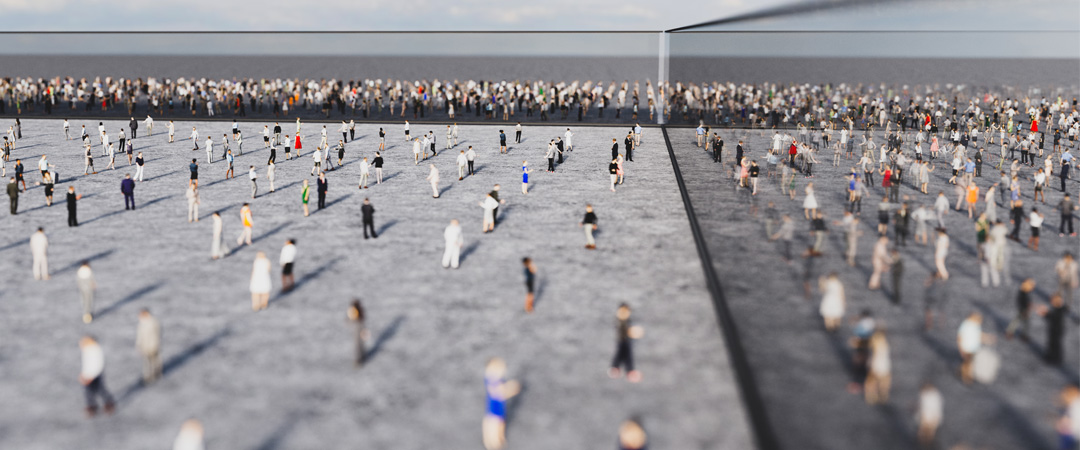
COUNTING MISSIONARIES
HISTORIC AND PRESENT CHALLENGES
BY DR GINA ZURLO
Dr. Zurlo is also a demographer of religion and studies every religion in every country of the world in the past, present, and future. Her scholarship is interdisciplinary in nature, intersecting history, sociology, and World Christianity. She is Co-Director of the Center for the Study of Global Christianity at Gordon-Conwell Theological Seminary, where she edits the World Christian Database. She is also a Visiting Research Fellow at Boston University’s Institute on Culture, Religion and World Affairs, founded by sociologist Peter Berger, where she edits the World Religion Database. During 2023–2024, Dr. Zurlo is a Yang Visiting Scholar in World Christianity at Harvard Divinity School and she will be visiting New Zealand, holding a public meeting on 12 July 2024. This article is curated from the Overseas Ministries Study Center blog.
Numbers have always been a part of the modern missionary enterprise. In fact, missionaries were among the first of what we would now call social scientists. Highly educated, cross-cultural missionaries all over the world gathered data on religion, conducted population surveys, and reported findings to their home base of support. Data on religion served as measurements of success or failure as well as motivation for starting new missions.
Part of their work was counting missionary personnel—tracking how many missionaries were serving abroad and keeping records of their activities. For hundreds of years the Roman Catholic Church has maintained an impressive data collection enterprise with Annuario Pontificio, the statistical annual released by the Vatican every year, and Annuarium Statisticum Ecclesiae from the Central Statistics Office of the Church. These two texts include data on personnel in the Holy See as well as complete lists of all Catholic dioceses in the world, including data on many churches, religious orders, mission stations, Catholic populations, seminarians, educational institutes, priests, as well as baptisms and marriages.
For Protestants, James Dennis (1842–1914) was the premier missionary number-crunching at the turn of the 20th century. The supplement to his Christian Missions and Social Progress was a comprehensive collection of statistical data on missions with carefully tabulated statistics of societies engaged in foreign missions, including figures on educational activities, literacy, medicine, and missionary training institutions. He included missionary wives as foreign staff in their own right, not as auxiliaries to men, and thus helped legitimize their role in missions. In 1902, Dennis included data on 134 US mission organizations in his Centennial Survey of Foreign Missions. He reported 5,588 total foreign missionaries, 64% of whom were women. Another study by Harlan Beach (1903) covered 318 US societies, reporting 3,344 female missionaries, 57% of all American missionaries. The 1910 Statistical Atlas of Christian Mission included 170 US and Canadian missionary sending bodies, consisting of 3,924 women, or 59% of all missionaries. The Statistical Atlas also included a map with tiny red dots that indicated mission stations around the globe.
Decades after these early estimates, David Barrett conducted a global census of the missionary movement (though notably and unfortunately, dropped the gender variable). In the 1982 edition of the World Christian Encyclopedia, he reported 249,000 “foreign missionaries and personnel” plus an additional 32,500 “Third-World” foreign missionaries. He observed a decline in missionaries sent from Europe and North America (particularly Catholics), and growth among missionaries from so-called Third-World countries, commenting on the latter: “They are rapidly increasing each year in numbers and in the geographical extent of their service.”
The Center for the Study of Global Christianity has continued to track missionary sending and receiving worldwide, with our latest estimate published in the World Christian Encyclopedia, 3rd edition (2019). However, it is much harder to count missionaries now than it was in the 20th century when James Dennis and David Barrett made their estimates. The trend is not only Northern decline and Southern growth, but also mainline and Catholic decline and increase of Independent, Evangelical, and Pentecostal/Charismatic missionaries. The latter are usually less tied to institutions, and thus more difficult to track. That is, missionary sending has become more decentralized compared to the past, as well as much more global, and thus more complicated.
To give a sense of the complexity, here are four categories that give a sense of scope to the movement:
The first category is Christians in diaspora. We already report figures for Christians on the move via our ethnolinguistic peoples database, and we can make some reasonable assumptions on the connection between missions and migration (see for example the work of Jehu Hanciles and Harvey Kwiyani). Measuring mission by this approach would provide hard estimates for Christians working abroad (in a variety of areas) but does raise questions as to whether every Christian working abroad can be appropriately considered a missionary.
The second category is organizational missionary sending, such as the figures reported by Catholics, the International Mission Board of the Southern Baptist Convention, Missio Nexus (compiled from many Protestant organizations), and the Church of Jesus Christ of Latter-day Saints. However, as discussed above, it is not possible to contact every single missionary sending organization in the world and assemble their statistics to create national, regional, and global totals. One method would be to choose an organization as a representative of sorts for a particular country or region, but that would indeed be painting with a very broad brush and only give a glimpse into the reality.
The third category is individual church-based missionary sending, which is the least trackable but likely makes up a large portion of sending worldwide. This is sending from congregations, not through an organization, that is largely “off the map” from researchers.
The final category is what has up until now been called “national workers,” defined as Christians working cross-culturally within their own countries, such as South Indians working in North India or Nigerians working among Muslims in northern Nigeria. Questions are being raised as to how different this kind of missionary work is compared to someone arriving from another country, but the one coming from abroad is called a “missionary” and the local Christian a “national worker”—though each doing the same work.
We cannot quantify missionary sending and receiving today like Dennis and Barrett did in the past. It would not be possible to create a database of all missionary-sending organizations worldwide—including independent churches that are not connected to formal sending bodies—and then individually contact them to ask how many missionaries they send and to where. World Christianity is simply too large and too diverse. But at the same time, we cannot simply abandon the topic altogether, as missionary sending remains an important feature of Christian life and commitment around the world.
These are just some of the questions involved in the science of counting. This total reassessment of the missionary enterprise requires reviewing literature, discerning trends, revising definitions, and operationalizing a constantly changing phenomenon. If you have thoughts or suggestions for us, send us an email (info@globalchristianity.org).
BY DR TED ESLER
Ted Esler is the President of Missio Nexus, the US American association of agencies and churches representing over 50,000 Great Commission workers worldwide. Ted worked in the computer industry before serving in Sarajevo, Bosnia, during the 1990’s. In 2000, Ted became the Canadian director of Pioneers and three years later moved to Orlando to join Pioneers USA’s leadership team. He was appointed the President of Missio Nexus in 2015. His most recent book is The Innovation Crisis, Creating Disruptive Influence in the Ministry you Lead. Ted has a PhD in Intercultural Studies (Fuller Theological Seminary, 2012). This article is curated from Ted’s Substack, TedQuarters, April 26, 2023.
Churches tend to have a “pull” model, in which they seek to pull diaspora ministry into their church. I mean that literally. They want the English-as-a-Second-Language course taught in their church building. They invite immigrants to join them. They host activities designed to expose their congregations to immigrant communities to see them engage in the life of the church. It is a good approach that many churches are using to great effect. Immigration-focused ministries like World Relief excel in helping churches do this kind of ministry. It also aligns with much of the church growth philosophy prevalent in many churches. I have heard it from the pulpit in the last few weeks: the way to grow in Christ is to go to church. The church is where you will be discipled. It fits a pastoral worldview. They believe this approach has the greatest potential in reaching the community.
Missionaries tend to work on a different paradigm. Particularly those moving “back home” from distant cultures. They focus more on contextualizing ministry to the culture being reached. We could call this a “push” model. Rather than inviting diaspora communities to join majority culture congregations, they apply an incarnational model. They move into the community with the goal of starting an indigenous congregation. They are not building on an existing ministry so there is nothing to invite people to join, at least not in the beginning. They learn the language (if they do not speak it already), eat the food of the diaspora community, seek to develop leaders from within that community, and avoid inviting people to join majority culture congregations. This is the mentality of the missionary. They want to plant an “Afghan Church” as they believe it is the best way to reach the larger community of Afghans. A motivation for this is that they want to pass on leadership to Afghans who will then reproduce Afghan churches.
The multicultural church movement is seeking to create a “third way” that is neither reflective of the majority culture nor a particular culture. This is a reaction against homogenous churches, either homogenous by being majority culture churches, or homogenous by being from the culture of a particular diaspora community. Their strength is diversity. Their weakness is their foreign nature. Advocates of multicultural churches often say that this “foreign culture” is Kingdom culture. A visit to one will reveal a different feel than a homogenous church offers. In other words, multicultural churches are their “own thing.” I would imagine their numbers will grow as our culture becomes more diverse.
The push and pull models exist because of the nature of the groups involved. Church leadership teams cannot help but think about growing the footprint of the church. That is why the team was built. Missionary teams are going to focus on planting indigenous churches for the same reason. It will be hard for either the “pushers” or “pullers” to break out of this mentality. This should remind the reader of the innovator’s dilemma. Creating new teams, free from commitments to either focus, may be necessary to overcome this reality.
So, if you are designing diaspora outreach for a denomination, keep in mind the inherent difficulty of getting people to rethink their paradigm. Choose the outcome you desire first. If you are hoping to serve the needs felt by church leaders to do outreach into diaspora communities, you should consider a pull strategy. If you are hoping to plant new churches cut from the cloth of different cultures, the push strategy may be more effective. If you foresee a day when multicultural churches are your norm, you can design the approach around this concept. In any case, you should avoid putting new wine into old wineskins but create something specific to the outcome desired.
BY TIMOTHY GOROPEVSEK
Timothy is the Executive Editor for Christian Daily International, a global Evangelical Christian online news service. He previously served as the Chief Communications Officer of the World Evangelical Alliance for more than eleven years. Originally from Switzerland, he studied theology and journalism in the United States and is currently completing his PhD in Global Theology with a focus on effective media engagement.
In recognition of a new era in global missions with greater participation by the Majority World (MW: Africa, Asia, Latin America, MENA [Middle East and North America]) (Ed. and the Pacific), a recently formed group of missions, church, and market-place leaders from Asia and Latin America issued a communique with recommendations for missions practice for the Majority World.
Meeting in Bangkok, Thailand, from May 1-3, 2024, the group called COALA—which stands for “Christ over Africa, Latin America and Asia”—emphasizes the importance of unity and partnership in missions and hopes the recommendations would start off conversations in the global Church.
The Bangkok meeting that brought together 38 missionaries, missions leaders, and pastors from 30 nations was a follow-up to an earlier gathering in June 2023 under the auspices of the Korea World Mission Association. (Ed. That June gathering was a direct response to content shared at the World Evangelical Alliance Mission Commission’s Global Consultation in Chiang Mai, Thailand in February 2023.) At the May 2024 Bangkok meeting were participants from Latin America that included leaders from COMIBAM (Cooperación Misionera Iberoamericana), a movement that brings together national mission groups and networks in twenty-five Latin American countries, as well as Spain, Portugal, and Hispanics from the United States and Canada.
“Discussions focused on the changing shape of global missions from a Christendom model to a truly polycentric missions orientation,” the group said, pointing to the “recommendations towards some principles for healthy Majority World missions engagement in a polycentric era of missions” as one of the key results of the meeting.
With the heading “Greetings to the Global Church of our Lord Jesus Christ, all missions movements & networks,” the communique on COALA 2 begins by outlining the geographic shift in global Christianity towards the (so called) ‘Global South’, highlighting the role of Majority World missionaries, and then calls for unity and authentic partnership in missions within the global Church as a whole.
“The 20th century has witnessed a major shift in the shape of the global Church. For the first time in the modern period, the center of gravity of the Church has moved from the West into the non-Western or Majority World. Today, two-thirds or more of global Christians reside in the latter,” the preamble states.
“Side by side with this shift, we have also seen a relative numerical decline of cross-cultural missionaries being sent out from the West, with the gap increasingly being filled by those sent out from the Majority World. The overall result of the above is that some countries that were mission fields in the past are now increasingly being recognized as missionary sending nations. Further, some that used to be sending nations are now receiving missionaries back from formerly receiving nations.”
“Given the above, many in the global Church today recognize that we are now living in a new era of polycentric missions, wherein missions today is from everywhere to everywhere. The above have important missiological consequences for the global Church, both the Western and the Majority World churches.”
“As a group of missions workers from the Majority World, we have some real concerns over the involvement of Majority World churches in cross-cultural missions. We would like to propose some recommendations for further reflection and discussion by the wider Church,” the preamble concludes.
Recommendations emphasize relationship with locals, and address concerns about money in missions.
The recommendations begin by stating the centrality of the Holy Spirit, emphasizing, “The primacy of the leading and power of the Holy Spirit in missions: In accordance with the Lord Jesus’ instruction (e.g. Luke 24:49; Acts 1:4-5, 8) and the example of the Apostles in the New Testament, especially in Acts, we affirm that missionaries sent out must go under the leading of the Holy Spirit and in His power. It is primarily the work of the Holy Spirit which makes missions possible and fruitful.”
Among the primary concerns, the recommendations then go on to highlight the relationship of the missionary and the local church, the role of finances, and the general spirit of unity and partnership.
“Missionaries and related cross-cultural workers should always go with a servant heart and attitude, and with humility and respect towards the leaders of the local church and their indigenous co-workers. Their reliance should always be on God and not on their superior educational background or the resources that they bring from outside,” one of the recommendations says.
The following then continues along the same lines, saying, “The goal of missions is to build the local indigenous church which is marked by self-government, self-support, self-propagation and self-theologizing. Therefore, missionaries should never build churches centered around themselves or their sending bodies, which remain dependent on them and the resources they bring.”
Regarding the relationship with existing local churches, the recommendations state, “As far as possible, a missionary should work with local churches with a Kingdom mindset which is concerned to build the whole church of God in a particular region or nation. Churches should never be planted and built in isolation.”
Where possible, missionaries and church planters should become part of existing denominations or church networks, the recommendations say.
They add that “missionaries should always hold themselves accountable to the local church or body where they are working. Thus, missionaries sent out should know how to network with local believers and, and as far as possible, be willing to serve under local leadership.”
Emphasizing that locals are more effective in sharing the gospel because of their understanding of the context, the recommendations say that “Missionaries should see themselves as midwives, and not mothers. They must therefore respect the local churches and allow them to make all important decisions in a contextual and culturally-sensitive manner, albeit based on Scriptural teaching.”
“The most effective witnesses of the gospel are indigenous believers and the local church. To this end, missionaries should encourage all indigenous believers and available local church-related institutions to take responsibility and initiative for the growth of the church. The missionary’s major tasks are to train and work alongside local believers and institutions,” they continue.
Speaking about the critical issue of financial support, the recommendations acknowledge that “money is a matter of crucial concern in missions. It can bring great blessings; it can also cause much damage in the long term.”
“We therefore urge missionaries and their sending bodies to exercise extreme care in this matter. We need to avoid models which lead to a standard of living for the local Christian worker which is higher than the local average or to initiate expensive projects which the local church will find difficult to sustain long-term,” the recommendations emphasize.
Finally, the recommendations call for unity and partnership, saying “we are called to unity in Christ (John 17:11,21), which should be expressed as genuine partnership in the work of the Kingdom of God.”
In order to achieve such partnerships, they call for serious consideration of two recommendations.
Firstly, “God has given us a clear mission mandate in Matthew 16:18 and 28:19-20. Together with this, we believe also that God has given all the resources needed for the advancement of the work of the Christ’s mission, be it spiritual, human and financial. Such resources are to be shared as much as practically possible by all involved: between the local church and the missionary; between the mission(ary) sending and the receiving churches; and between churches and missions agencies working across the world.”
And secondly, the recommendations conclude saying, “In this era of polycentric missions, we affirm that genuine partnerships must be developed between all churches everywhere, between those in the West and the Majority World, as well as among all churches in the Majority World. The challenge before us to fuse all our God-given resources together into a powerful synergistic whole for world mission.”
Stretching out the hand for partnership between “Global South” and “Global North”.
In a soon-to-be published in-depth interview with Christian Daily International, Rev. Jonas Kang, Chairman of the Korea World Mission Association, shared how COALA emerged from the World Evangelical Alliance’s Mission Commission consultation in Chiang Mai, Thailand, in 2023. Dr. Gina Zurlo’s presentation on the shift of global Christianity to the South sparked conversations among a group of mission leaders from Asia and Latin America.
In a follow up meeting in Korea a few months later, the Majority World leaders came together to talk about a new paradigm in missions, without participation of mission leaders from the Global North at first.
However, Rev. Kang emphasized that the Majority World leaders recognize and are grateful for the centuries of Western missions that brought the gospel to the whole world. Therefore, they desire for collaboration with those in the Global North and wish that the whole Church together engages in missions united in partnership.
As one of the first initiatives in pursuit of this new collaboration, Rev. Kang led a delegation of Korean mission leaders that participated in the European Leadership Forum (ELF) in Wisla, Poland from May 25-30, where they hosted a session titled How Can the European Church and the Korean Church Work Together?, as Christian Daily reported earlier.
Lindsay Brown, who served with the International Fellowship of Evangelical Students (IFES) for many years and formerly led the Lausanne Movement as International Director, facilitated the session at the ELF.
In his own comments to Christian Daily, Brown reflected on the changes in global missions and said,
…the leaders of one of the largest missionary forces from Korea are saying that they would like to partner with Western churches as equals. Not as subservient cross-cultural workers, but as a body of people who have an equal say and an equal commitment to the advance of the gospel globally.
They would like to dialogue together about the key theological and missiological issues that need to be addressed, and to be involved in active partnership. They are taking initiative in putting their hands out, offering to serve together,” Brown said, and urged Western leaders to take note of that and respond.
They are stretching out the hand of fellowship and partnership. So, the Western mission leaders and church leaders should say, ‘yes, we want to partner!’ And they should rejoice in the invitation.
Executive Director
We at ECM Australia are looking for our next Executive Director. Is it you?
Are you passionate about developing kingdom workers and seeing God’s kingdom established in the hearts and lives of people in Europe?
Join us in our vision to re-evangelise Europe—to bring hope once again to lives hardened by secularism and the post-modern world.
We are seeking to appoint a new Executive Director for European Christian Mission Australia, based in Sydney.
We are looking for someone who will wholeheartedly embrace the challenge to:
- Provide visionary leadership for ECM Australia.
- Motivate and care for our staff team and volunteers.
- Recruit, encourage and induct new mission workers.
- Provide excellent pastoral care and oversight of existing field workers serving across Europe.
- Develop relationships with key evangelical churches, supporters and volunteers across Australia to raise ECM Australia’s profile and oversee fundraising.
- Grow healthy partnerships with churches.
- Inspire and motivate individuals.
- Manage the efficient, effective and sustainable running of ECM Australia through good governance and financial management.
We are seeking a team leader who is an effective communicator and is passionate about the development of our people here and overseas.
We encourage you to apply if you believe that God has called you to serve Him through ECM Australia, and you have a commitment to disciple-making and seeing mission workers live as true disciples of Jesus Christ.
If you are an inspirational leader who has a passion for cross-cultural mission, who enables teams and individuals to flourish and fosters an inclusive culture of spiritual discernment and prayer, this could be the role for you.
For more information or to apply, please head to ecmaustralia.org/executive-director.
BY DR MURRAY SHEARD
Murray is the Chief Executive Officer of cbm New Zealand and has worked in international development for over 15 years. He was born in Wellington and grew up in Thames. From there, he has lived and worked across the world, including a year within the walls of the Old City of Jerusalem. Murray joined cbm in August 2018, after working at Tearfund, where he led the department that introduced the Ethical Fashion Guide and the Justice Conference to New Zealand. Murray has a PhD in Ethics and Philosophy from the University of Auckland. Murray and his wife Joy have two young sons, Finn and Jamie. Friends with disabilities taught him a lot about the reality of their lives, and the difficulties they face.
“Isaac reopened the wells that had been dug in the time of his father Abraham…” – Genesis 26:18
Living in New Zealand, most of us are fortunate to have a constant supply of clean water to use for our everyday living. But that’s not the case in many of the world’s poorest places. Around the world there are millions and millions of people who do not have access to clean water.
With generous support from kind people like you, Christian Blind Mission (cbm) continues the fight against Neglected Tropical Diseases (NTDs), such as River Blindness which has shown incredible success over many years in Nigeria. Alongside the successful delivery of parasite-killing medication, which breaks the lifecycle of parasites that cause NTDs, cbm’s Water Sanitation and Hygiene (WASH) project focuses on clean water and good sanitation to prevent NTDs from taking hold again.
Good health and clean water go hand in hand. So, having access to clean water from well-maintained boreholes, helps free children and adults from contracting NTDs such as River Blindness and elephantiasis. It also means men, women, and children no longer have to spend hours walking to gather muddied and contaminated water.
Clean water helps keep people healthy. And healthy people are more likely to be able to access education, have better livelihoods, and have a far greater chance of breaking the cycle of poverty and disability. The major success factor of cbm’s WASH programme is to provide clean water through fixing broken boreholes, also making them accessible for people with disabilities.
Clean water from boreholes is vital to a community, but many existing boreholes have ceased to function for various reasons. They are often found broken and in need of repair due to their age. The only place to get water is from an open well or a river where there is great risk of contamination and pollution, and a greater risk of contracting NTDs.
But thankfully, this is where your loving kindness comes into the picture.
As we celebrate World Humanitarian Day on 19 August, and having recently visited Nigeria, I ask for you to prayerfully consider making a special gift to help ensure clean water, and good sanitation and hygiene practices are accessible to communities, including people with disabilities. This will help prevent children and adults in local villages losing their sight due to River Blindness.
With support from generous people like you, new or refurbished boreholes will provide communities with a centrally located source of clean water. The addition of wheelchair ramps will make the task of gathering water safer and more accessible to people with disabilities.
Right now, there are children, adults and whole communities in great need of clean water in places like Nigeria… and your generous support can change that.
By sending your gift, you selflessly make it possible for clean water to be made available to local communities, and you will also be helping to set up WASH Clubs and install handwashing stations at primary schools. When I was in Nigeria, I visited a small community and their school where a WASH Club has been set up. The children were excited to have access to clean drinking water, and to learn about improving their personal sanitation and hygiene practices.
The children happily demonstrated their new hand-washing skills, and showed me how to wash my hands using soap and ‘tippy-taps’. These ‘tippy-taps’ were filled with fresh clean water from the refurbished community borehole, and constructed from low-cost recycled materials.
Whilst in the area, I also spoke with people in the community who were trained by cbm’s partner to repair wells. One of them was Chetachi, who could not walk unaided, and had a friend carrying his tools. “Before there was no clean water and now, this is no longer an issue,” he said, with a beaming smile. Chetachi is trained by cbm’s partner to maintain borehole pumps, and repair them when broken. Because of this training, Chetachi, and other people with disabilities, now have jobs and feel valued and included in the community.
I spoke with other people in the community who now have access to clean water from their newly refurbished borehole. They spoke of their gratitude to generous people like you: “We are so grateful to people in New Zealand who support us through cbm. Our children will not suffer like their grandparents did, because of their generosity.”
Whilst this community is now thriving, right now in other villages in Nigeria there are many children and adults in desperate need of clean water… but your generous support can help change that. It will help provide new or refurbished boreholes so communities can have a centrally located source of clean water, with the addition of wheelchair ramps to make the task of gathering water safer and more accessible for people with disabilities. I have seen first-hand what WASH does for a community. It is life-changing for all, but especially for people with disabilities who often cannot access clean water due to their disability.
We thank God—especially for your faithful support of people with disabilities. But we are also deeply concerned that right now there are so many children and adults who cannot access clean water in the world’s poorest places. Please will you help provide them with clean water to WASH away the misery of NTDs that can have lifelong health and economic consequences?
Lastly, I want to leave you with a quote from cbm’s WASH partner. It’s a wonderful testament to the faithful giving of generous people like you. The Director said to me: “Many charities want to come in at the end when we are winning the battle against NTDs. But cbm has been there from the start.”
My challenge to you is, let’s continue the incredible progress made over many years to combat NTDs. Please prayerfully consider sending a gift today by phoning 0800 77 22 64 or on cbm’s website www.cbmnz.org.nz/wash.
With your generous support, let’s WASH away the misery of NTDs!
Thank you for your kind and caring heart. May God bless you.
BY MIHAI LUNDELL
Mihai and his wife Tamara are members of the Global Member Care Network and the European Member Care Network, based in Genova Italy. They are workers with One Challenge ministering in both with their local church in Genova, Italy, and throughout Europe, supporting other missionaries within One Challenge. Their roles within the local church include supporting a growing young adult community, and supporting refugees living in Genova. Mihai serves as chairperson of the European Member Care Board for One Challenge. This article was first published in the May 2024 Member Care Network newsletter.
For over the past ten years in Member Care, we have talked a lot about the “pyramid of care” and how local resources, nationals, etc., can all play a significant role in providing care. The following is a true story of what that can or may look like!
“Do you have a mirror,” she asked, “Because I don’t know who I am.” These are words I will likely never forget from a Palestinian woman fleeing both Gaza and her husband.
This past April I spent six days along the Red Sea Coast in southeastern Egypt providing trauma counseling for children with UNICEF (United Nations International Children’s Emergency Fund). Every month in my home town of Genoa, Italy, I counsel various refugee children fleeing the horrors of war. Many of the counseling sessions are done in English with a translator. After the escalation of the conflict in Israel, UNICEF contacted me and other counselors at our pediatric hospital to see if we would be interested to go to Egypt at one of the refugee camps to help children process their trauma. We, of course, said yes.
Upon arriving at the airport in southern Egypt, I knew this was going to be a challenging six days.
Out of our team of 20 counselors, only two of us were Christian. With each passing day, the UNICEF trucks would bring in new people, children from Israel, Gaza, Syria, Afghanistan, Sudan, Libya, and Ukraine. I was assigned to the males, as naturally, men were not allowed to talk directly to the Muslim women. By the second day, I was already exhausted. Not physically, but emotionally by the stories the children told. My heart was heavy. Then God did something miraculous!
In the afternoon of the second day, I was assigned to a young, Palestinian child who fled Gaza (for the sake of privacy, we will call him Efram). Because Efram was so young, his mother asked to participate in the counseling sessions with me and a translator. Before I even began to listen to Efram, his mother got up and started screaming in Arabic. Throughout the complex, all eyes were instantly drawn to this Palestinian woman screaming. I asked my translator to please translate what she was saying.
She kept yelling, “Enough!” in Arabic. She then proceeded to slowly take off her Hijab and burka and throw them into the pool of the complex. She was now standing there in front of everyone in nothing but her undergarments. But she was yelling something else now: “Enough! Enough of serving a God and a culture who say I need to cover up because I’m not pure or worthy! Enough of a culture who says my testimony is worth half that of a man only because I’m a woman. Enough of blaming others for our decisions! I can’t take it anymore. I’m done.”
No one knew what to say or what to do. To put this into context, her words did not exactly sit well with those who heard her—this was Egypt after all—a Muslim culture, and she was surrounded by many other Muslim women who did not appreciate what she was screaming.
Then she turned to me and said (another taboo, as Muslim women don’t often directly address a man) and asked me, “hey you, aren’t you one of the Christians here? I thought I saw you with a Bible.”
I had to look at my boss to see if it was okay that I said I was a Christian, seeing as I was contracted with UNICEF. He nodded to indicate it was okay. She then asked, “What does Jesus say about women?” I looked up to the sky, smiled, and said to myself, “Lord where did this gift to evangelize suddenly come from?”
I knew I didn’t have much time to answer this woman and I knew translation would be difficult. Wheels were spinning in my head. Then the idea came to me to find the clip from the series “The Chosen” on my phone via Youtube where Jesus meets the woman at the well. Thankfully, I was able to find Arabic subtitles and get the woman to watch the clip. Tears instantly came streaming down her face. She then asked me a series of questions: “This woman wasn’t a Jew and Jesus asked HER for water? Didn’t this take place in my land? (She is a Palestinian woman). And Jesus was patient and kind and showed mercy to her? And she didn’t have to hide from him?”
Then she got up and started screaming again, but this time with her hands in the air and one of the widest smiles I have ever seen, saying in Arabic again “I want to know Jesus! I want to know Jesus! I want to know a God who sees me. Who here can tell me more about Jesus.”
My boss looked at me and said, “what have you done?” I answered, “the beauty of it? I honestly didn’t do anything!”
Finally, the woman stopped and asked if someone had a mirror, because in her words, “I don’t know who I am. I know who my husband (now ex-husband) says I am and what this culture says I ought to be, but I don’t know who I am.” She then asked some of the women if they would take her shopping because she said she has no idea how to do her hair or how to shop for other clothes.
The rest of our days with this woman, my colleague, the other Christian woman, and I walked this woman through Genesis 16 and the story of Hagar. Usually, the story of Abraham and Sarai is told through their perspective, but my colleague and I told this woman that God heard Hagar, saw her, and that she in turn calls God by the name EL Roi, the God who sees me! Never has that passage meant so much to me.
Since the woman had a talent for drawing, her therapy for the week, was to eventually be able to draw herself so that she could ultimately be able to say…. “THIS is me; this is who I am. “
We talk in Member Care a lot about the new paradigm shift in care and that locals and lay people can provide care as well as the professionals. In this instance, who is the caregiver who is going to have the most impact in this woman’s transformation? It’s not just my colleague who helped her draw herself in those six days, but it’s also the women who will take her shopping, who will help her find a style to do her hair, and the women that will sit with her and remind her that Jesus is indeed El Roi, the God who sees her!
This woman has a difficult road ahead of her, as she has chosen to not return to her home but wants to seek an education and a new career path in Europe, where she will hopefully be safe to study and learn about Jesus. She has, arguably, already passed through the most difficult step. She has chosen new life with Jesus! Who else will be providing care for this woman? The church community who receives her in Europe and the people who will receive her in her new home. It will be a collective effort, a true pyramid of care! Her story is just beginning, and I am so glad I got to be a part of it!
Jesus met her there in Egypt, saw her and He, El Roi, has set her free!
BY DR RAVI DAVID
Ravi is from Bangalore, India and after having lived for ten years in New Zealand with his wife Mercy, they have been based in Atlanta, Georgia for the past eight years. Ravi has a PhD in Practical Theology from the University of Auckland, New Zealand and serves as an adjunct Professor at SAIACS in Bangalore and AGST Nepal. His ministry is to ”equip and encourage” missional and pastoral leaders. This is done through various church and mission agencies/networks such as the India Missions Association (IMA), the Global Member Care Network (GMCN)of the World Evangelical Alliance, CIEMAL in Latin America and the Caribbean and TMS Global, in Georgia, USA. This involves extensive travel. This article was first published in the June 2024 Member Care Network newsletter.
Half of the year 2024 is over! Time indeed goes fast and the world seems to have moved forward after the pandemic years. However, the new season is not necessarily the same as what it used to be prior to March 2020 BC (Before Covid!). There is a lot more uncertainty, anxiety and a sense of angst in our world. The overall mental and emotional health of many people has been affected because of the trauma, trials and turmoil that the world went through during the pandemic.
Walter Brueggemann suggests that human beings regularly find themselves in one of three places:
- a place of orientation, in which everything makes sense in our lives;
- a place of disorientation, in which we feel we have sunk into the pit; and
- a place of new orientation, in which we realize that God has lifted us out of the pit and we are in a new place full of gratitude and awareness about our lives and our God.
Several Psalms in the Bible reflect this journey of moving from a place of orientation to a place of disorientation and then to a place of new orientation. The 23rd Psalm is a familiar one which begins with the Psalmist being in a place of sufficiency because the Lord is his Shepherd. The psalmist reflects on his life and describes the landscape—lying down in green pastures, led beside still waters—resulting in a soul that is restored (orientation).
Then comes the season of walking through the valley of the shadow of death (disorientation). There is a complete change of circumstances from a serene domain to severe darkness. How did the psalmist navigate this part of the journey? He reflected on the fact that God is with him even in the valley of the shadow of death. Therefore he did not fear the darkness. Because he recognised God’s presence with him during the green pasture-still water times. He was able to recognise God’s presence even in the dark night of his soul.
The journey from orientation to disorientation can be quick, sudden and unexpected. But the journey from disorientation to new orientation is slower as we grope our way through the darkness. “Who among you fears the LORD and obeys the word of His servant? Let the one who walks in the dark, who has no light, trust in the name of the LORD and rely on their God.” Isaiah 50:10
The journey of the psalmist through the dark valley (disorientation) was navigated and sustained by both the knowledge and the lived reality of the Shepherd’s presence at all times. The rod and the staff of the Shepherd comforted and directed him through invisible paths along uncharted territory. He felt the anointing oil even when he could not see it and this brought him overflowing joy while still walking through the dark valley. This led him to be confident and absolutely sure of God’s goodness and mercies to not only pursue him all the days of this life, but even into eternity (new orientation).
What a great, good and gentle Shepherd we have.

PRAYERLINKS
PRAYER FUEL FOR MISSIONS
As we celebrate Bible Month this July at Bible Society, God, we are deeply grateful for the unwavering foundation that Your Word provides in a world filled with uncertainty. Please pray that NZ Bible Society’s prepared resources may enable ministries, families, and individuals to unlock the profound truths within the Word. Lord, guide us on this journey, and let the truths we discover strengthen our faith and draw us closer to You. In Jesus’ name, we pray. Amen.
FEBC ELSEA (Ethnic Languages of Southeast Asia) shared that 52 Hmong students recently received certificates for completing the FEBC Bible course. Praise God for raising disciples to tell the nations about Jesus’ incredible love. We also distributed 20 radios to coffee plantation workers who can now hear the stories of Jesus in a language they can understand. Pray for a great harvest of hearts to turn to Him. Furthermore, an entire Mien village decided to follow Christ and got baptised after hearing FEBC broadcasts. That’s 24 adults in one glorious event! Praise God! Pray that many more hear FEBC broadcasting the good news, and turn to Jesus Christ.
Missions Interlink operations are well in the midst of the transition to a new administrator, a process that will be completed on 31 July 2024. Pray for Jay and Pauline as they hand off responsibilities to Ben Poulton. Pray for Ben as he learns all the necessary tips and tricks to keep the business of Missions Interlink operating well. Pray too for the meetings planned for Dr Gina Zurlo’s visit, especially the public meeting at St Margaret’s Anglican Church in Hillsborough Auckland on 12 July 2024.
Pray for each of our OMF candidates as they learn more about what life on the mission field might look like for them, for growing trust in God’s ability to provide, and for patience as they wait on God’s timing for them to go. Pray that the waiting time would be a time of growing in their faith rather than a time of frustration. Pray too that they would be able to build around them a group of people who will pray for them and support them as they go.
Please pray for an increase in SIM prayer groups from the 12 already lifting up our workers faithfully each month.
At the request of some within the NZ Deaf community, Wycliffe NZ, Bible Society NZ, and the NZ Deaf community have started work on a New Zealand Sign Language (NZSL) Bible translation. Praise God for excellent collaboration between the organisations. Please pray for us in these initial stages as we look to partner with more people and churches within the deaf community—for the right people to come forward to be involved, and for provision of costs involved. Praise God for the help of Fiona Alley, from the deaf community, who has been helping guide us through the nuances of sign language and deaf culture.
A MISSIONS INTERLINK MASTERCLASS
Friday 12 July, 2024 | St Margaret’s Anglican Church
Costs: Free Zoom: Yes Registration: Extended to 9 July 2024.
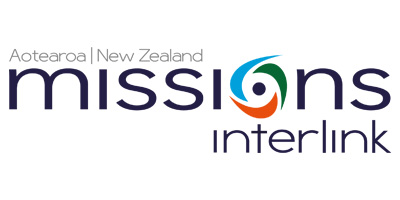
Dr Gina Zurlo
World Christianity Specialist
Gina is a world renown Christian demographer and historian who holds a PhD in History and Hermeneutics from Boston University School of Theology (2017). She is an interdisciplinary scholar, crossing between history, sociology, and World Christianity with particular interest in women’s experiences of Christianity and church life worldwide.
She is the Co-Director of the Center for the Study of Global Christianity at Gordon-Conwell Theological Seminary (South Hamilton, Massachusetts) and Visiting Research Fellow at Boston University’s Institute on Culture, Religion and World Affairs.
Gina was named one of the BBC’s 100 most influential and inspiring women of 2019 for her work in studying religious statistics, and, in particular, the future of religion worldwide.
Gina will share findings from her research into the growth of Christianity around the world. These findings are sure to surprise and encourage you!

SPOTLIGHT ANNOUNCEMENTS
LATEST NOTICES & EVENTS
BIBLE MONTH IS HERE!
It’s Bible Month at the Bible Society Group! Let’s embark on this collective journey throughout July as we uncover the Truth found in God’s Word together. We have a range of free resources available for ministries, families, and individuals at: biblemonth.nz.
CO-MISSION COURSE
Curious about Christian missions? Join OMF’s five-week Co-mission course and explore four key perspectives on mission work. Discover God’s heart for mission and find your unique role in His plan. For more information visit:
https://omf.org/nz/event/school-of-mission-winter-edition/
NATIONAL TEAM LEADER VACANCY
Do you have a heart for issues of injustice and serving the poorest of the poor? Have initiative and leadership skills? Dignity Freedom Network (DFN) is seeking a National Team Leader to raise awareness, prayer and finances to support a transformational, nationally led and run holistic organisation in South Asia. For more information email: info@dfn.org.nz.
REBUILDING: WHAT IS GOD DOING IN TÜRKIYE TODAY
NZ TURKEY NETWORK NATIONAL CONFERENCE
Recovery & rebuild efforts continue after the Feb 2023 quakes, and the physical & spiritual landscape of Türkiye continues to change. Come and hear stories of God at work in remarkable ways, keep up to date with what’s happening on the ground and hear the heart of Turkish leaders. Plus join an interactive workshop space, virtual 7 Churches tour and prayer journey.
Dates:
Friday 26—Saturday 27 July, 2024
Venue:
City Church
346 Manchester Street
CHRISTCHURCH
MORE INFO & TO REGISTER:
https://events.humanitix.com/national-conference-2024
NGĀ HUNGA HOHOURONGO
Uncover the profound journey of Māori responses to the introduction of te rongopai (the gospel) into Māori society. Witness the fascinating clash of traditions as the Gospel and Christian scripture intersected with the sacred law of tapu, utu (rebalancing) and warfare. This course offers a captivating overview of ‘peace-oriented Christianity’ and its transformative impact on Māori.
Dates:
12-14 Aug. & 2-4 Sept.
9:30am-4:30pm
Venue:
Laidlaw College Henderson Campus
3 Smythe Road, Henderson
AUCKLAND
MORE INFO & TO REGISTER:
https://www.laidlaw.ac.nz/ngā-hunga-hohourongo/
EARTHQUAKE RELIEF: BUILDING TRIP TO ANTAKYA.
NZ TURKEY NETWORK
Do you have practical skills, a love for God and a willingness to go and serve? Come and help build tiny homes for families who lost their homes, friends and relatives in the devastating Feb 2023 earthquakes.
15 October – 5 November 2024 (Approx. only)
For more information, and to download an application form visit:
https://www.nztn.org/about/nztn#events
GLOBAL MEMBER CARE NETWORK 2024 CONFERENCE
The Global Member Care Network is working on their vision to bring the Global Member Care world together again for their 4th Global Member Care Conference, this time in Africa. The significance of this location is to serve African mission movements, while learning from their unique strength in missions and member care. Past experiences have shown that surprising connections and transformative insights happen individually, organizationally, and nationally when member care practitioners gather from various national missions movements all over the world.
Location: Nairobi, Kenya
Dates: 28 Oct – 1 Nov 2024
For more information visit: https://globalmembercare.com/conference-2024/
ABOUT US
Executive Officer Joseph Bateson (interim from 01/08/24)
Administrator Ben Poulton
Executive Team
Joseph Bateson (Chair), Glenn Carter (Vice Chair), Jon Horne (Treasurer), Andrew Marriott (Secretary), Rebecca De Jong.
MI Council
Arotahi (formerly NZBMS), Asian Outreach, Beacon Partnerships (formerly LeaDev-Langham), Church Mobilization Trust, Eastwest College, European Christian Mission, GC3, International Teams, Interserve, Laidlaw College, MotiVate, NZCMS, OMF, Pioneers, SIM, WEC, World Vision, with individual member: Jon Horne.
Our Purpose
We facilitate collaboration towards participation in mission from and within Aotearoa New Zealand. We nurture the missions community in Aotearoa New Zealand to connect, converse, and conduct mission with the aim of working together: on mission.
Connecting the missions community
from and within Aotearoa NZ
for God’s glory everywhere, always.
MI SERVICES include (but are not limited to):
MI BULLETIN & MI Online Member Directory
MI ManaakiApp (for retail discounts & coupons)
MI Research and Resources
MI Conferences, Clusters & Collaborations:
Admin, Mission Leaders, Church Mission, Diaspora,
Member Care, Mission Training, Mobilisation, & more.
HOW TO CONTACT US
PO Box 64 379
Botany 2163
Auckland, New Zealand
+64 9 320 4408
CLICK HERE to drop us a note.

